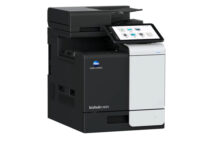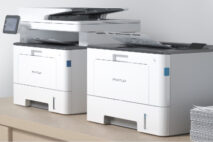This week, I have been thinking about patterns in printer hardware introductions. Actionable Intelligence routinely covers new printers and MFPs in its Product Briefings section, and over the last year and a half, I have noticed the acceleration of some trends that emerged well before that.
Consumer print volumes, long flagging, appear to have fallen off a cliff. As a result, even though inkjet devices still account for the majority of hardcopy hardware shipments worldwide (62 percent according to IDC’s latest numbers), these are, for the most part, low-volume devices that deliver slim profit margins, at least according to most OEMs’ recent financial results.
As a result, printer vendors’ consumer inkjet product rollouts are now lackluster events. Inkjet OEMs are milking print engines and consumable designs for as long as possible. When new supplies are introduced, the cost-per-page inevitably skyrockets from one generation to the next. Usually, the only truly new features on new consumer inkjets are new software and apps, more mobile printing features, or the connectivity changes necessary to take advantage of mobile printing.
Instead, most printer OEMs are chasing higher-volume users. Thus, virtually every printer hardware vendor is focused on tapping into the office environment, whether by introducing new business inkjet products (which is where all the innovation is seen in terms of new inkjet engine designs and inkjet supplies these days), rolling out the more traditional laser/LED-based platforms favored in this environment, or both.
The reason why is clear. Although office print volumes are declining (see “Office Printing: Growing or Declining?”), largely as a result of economic forces and job losses, a shift to electronic means of sharing and displaying information, and managed print services (MPS), paper is still a part of the workflow and everyday business operations in most offices. So while declining, print volumes in the office have not fallen as precipitously as in the consumer market.
The new breed of MFPs designed for the office are optimized for MPS contracts, with a focus on capture features and software and solutions that allow an MFP to serve as an on-ramp for digitizing content and managing an organization’s document workflow. In addition to improved workflow and capture features, the latest office devices feature lots of mobile printing features, so that no page that a mobile office worker might possibly desire to print is lost to the pernicious incursion of electronic alternatives to print.
When office printers/MFPs feature new supplies, the focus has been on low-melt toners, higher cartridge yields and improved CPP for those products likely to be placed via MPS contracts (although CPP seems to continuously increase on entry-level laser products), and chipsets that enable OEMs to protect the replacement cartridge market for as long as possible. Even Toshiba, which has traditionally experienced less aftermarket competition than some of its competitors, has made an improved chipset on its cartridges a key feature of its latest hardware rollout.
But, the question with new printer hardware is always a Field of Dreams-esque: If you build it, will they come? With much of the consumer inkjet printers that many vendors rolled out for many years, the answer was mixed. Sure, lots of consumer inkjet printers were placed, but many saw only occasional use and have delivered disappointing supplies margins.
Will the new generation of office hardware result in users printing more? That seems unlikely given that the very premise of MPS is getting businesses to save money by printing less.
Will the new class of office hardware result in improved margins for OEMs? That, too, is uncertain. Almost every vendor is introducing new hardware, supplies, and programs to get businesses to save on printing costs while offering software and services to make up for the money lost on printing. However, thus far, there is some evidence to show that this new dynamic leads to skimpier margins, not healthier ones. Take the dwindling profit margin in HP’s former IPG business, for example (see “HP to Lay Off 27,000, but CEO “Cautiously Optimistic” about Q2 Results”).
For third-party supplies firms, particularly toner cartridge remanufacturers, MPS provides an opportunity to grow share in the office environment for those that manage to find the right partners. In an office environment focused on reducing the cost of printing, non-OEM supplies have an obvious appeal. Indeed, the focus on MPS and attention from traditional hardware vendors like Muratec, OKI Data, and Samsung are breathing new life into traditional third-party shows, like next week’s World Expo.
So, readers, what do think about the latest crop of office devices? Will they drive print volumes for OEMs? Do you think they provide an opportunity for third-party supplies vendors to grow share? For how long can the aftermarket succeed if overall print volumes in the office continue to decline? Share your thoughts by commenting below. You can also email me privately at editor@action-intell.com.







1 Comment
I think too many times we assume what we see near us and that the practices and trends we read about or those thast make the most noise happens everywhere forgetting that more people worldwide ( the others to most of you) still are chasing more paper in offices , homes and schools in more countries and markets which are still developing , becoming richer , more educated , IT savy , discovering the internet , becoming more green . These consumers and end users for printers will gain ever more quickly larger share of printer sold , pages printed and supplies used and profits generated …and that one size fits all is long past …these countries find new ways to access printers , print pages and cut costs . In India for example literacy increases creates more users for prints as IT costs fall , internet creates more pages and more color pages and over 600000 copy shops and print services in small towns and many villages ( India alone has 600000 villages and 10000 cities/towns )who service hundreds of students , consumers and employees by profitably making available and delivering to their homes , offices and schools print outs and copies for as little as 2 US cents including cost of paper and color printouts and copies for 10 to 12 US cents only using after market products .OEM supplies may today by some estimates be only 16% of all cartridges being used even though by value terms OEM still have over 70% of revenues now approaching US$ 1 billion . Trends have to be seen along these lines and maybe new OEM like Siene’s pantum printers will help address markets outside the rich developed world which faces economic stagnation even as others are growing rapidly…will the OEM listen for days of fat supplies profits will not return despite all their efforts to protect their lucrative business as others today have technology and products to open doors even as OEM drive color, newer machines , chiped toner cartridges and cloud services . Want to bet on who will win ?